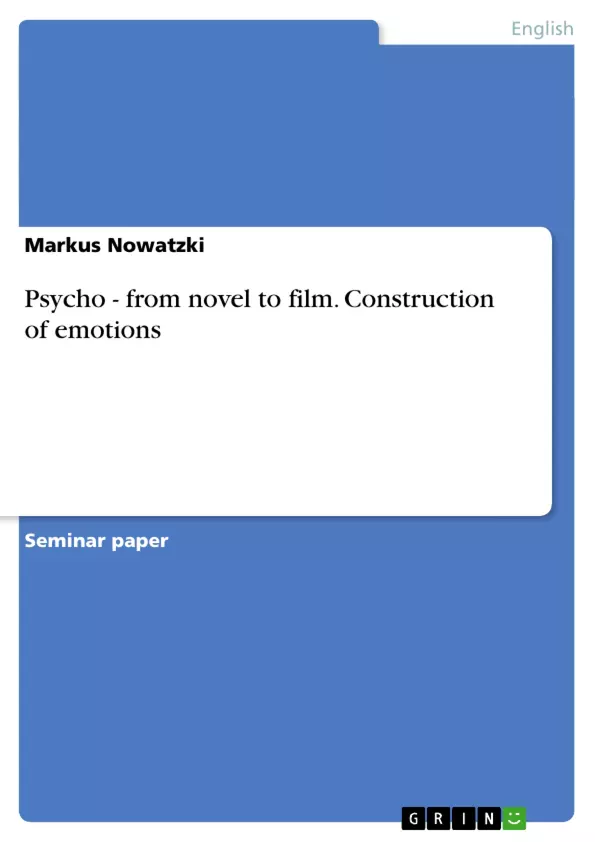About fifty years ago a little town in Wisconsin, Plainfield, was shaken by discovering a fiftyone- year old mass murderer living among them. Ed Gein, who had not only killed, but also disassembled his victims, was to become the role model as an archetypical character in the American horror literature.
It was Bloch’s curiosity about the dark side of Puritan America, about America’s psychology cult, especially about Freudian theories4 and the ever strong worship of a mother picture that transformed Ed Gein into Norman Bates, a bogeyman with an Oedipus fixation on “mother,” into a transvestite with a love for taxidermy.
At the time when Bloch wrote Psycho Hitchcock already had been a renowned film director. However, this constant success had put Hitchcock on his guard against the “trap of self-plagiarism.” In search for the unexpected, Psycho was his chance to further develop his style of suspense by entering a new field of the Gothic horror. Hitchcock’s trust in the story proved him right, because as the book seemed to be a winner, the film achieved a groundbreaking success until today.
TABLE OF CONTENTS
- INTRODUCTION
- CONSTELLATION OF CHARACTERS
- INSIDE THE BOOK
- READING THE FILM
- MARY
- THE RELATIONSHIP MARY-NORMAN
- NORMAN
- THE MATTER OF SAM AND LILA
- ARBOGAST
- THE STRUCTURE OF THE FILM AND ITS ELEMENTS.
- PLOT POINTS ACCORDING TO SYD FIELD
- ELEMENTS OF SUSPENSE
- CLOSE-UP: THE SHOWER SCENE
- CONCLUSION
- APPENDIX
- BIBLIOGRAPHY
- PRIMARY TEXTS AND MATERIALS
- SECONDARY TEXTS
- OTHER MATERIALS
- STORIES I-V
- BIBLIOGRAPHY
Objectives and Key Themes
This text examines the adaptation of Robert Bloch's novel Psycho into Alfred Hitchcock's iconic film. It delves into the construction of emotions and the exploration of suspense in the film, drawing comparisons between the book and its cinematic counterpart.
- The influence of Ed Gein and the American horror literature on the creation of Norman Bates.
- The transformation of the novel's characters and plot elements into the film.
- The role of suspense and its creation through cinematic techniques.
- The impact of the film's success and its legacy in the horror genre.
- The themes of dominance of the past over the present, sexual secrets, and repression.
Chapter Summaries
The introduction provides context by discussing the origins of the story in the real-life case of Ed Gein, a mass murderer who inspired Robert Bloch's novel. It also introduces the concept of the film's success as a departure from Hitchcock's usual style and its influence on the horror genre.
The chapter "Constellation of Characters" analyzes the characters in both the book and the film, highlighting key differences and similarities. It examines the development of Norman Bates as a complex character and the influence of his "mother" figure on his psyche.
The chapter "The Structure of the Film and Its Elements" focuses on the film's structure, analyzing its plot points and the elements of suspense employed by Hitchcock. It delves into the iconic shower scene and its cinematic impact, highlighting the techniques used to create tension and horror.
The chapter "Conclusion" is not included in this preview.
Keywords
The main keywords and focus topics include: Alfred Hitchcock, Robert Bloch, Psycho, suspense, horror, Gothic, Ed Gein, Norman Bates, Mary Crane, mother figure, shower scene, cinematic techniques, adaptation, book to film, character development, Freudian theories, American horror literature.
- Citar trabajo
- Markus Nowatzki (Autor), 2002, Psycho - from novel to film. Construction of emotions, Múnich, GRIN Verlag, https://www.grin.com/document/15016



